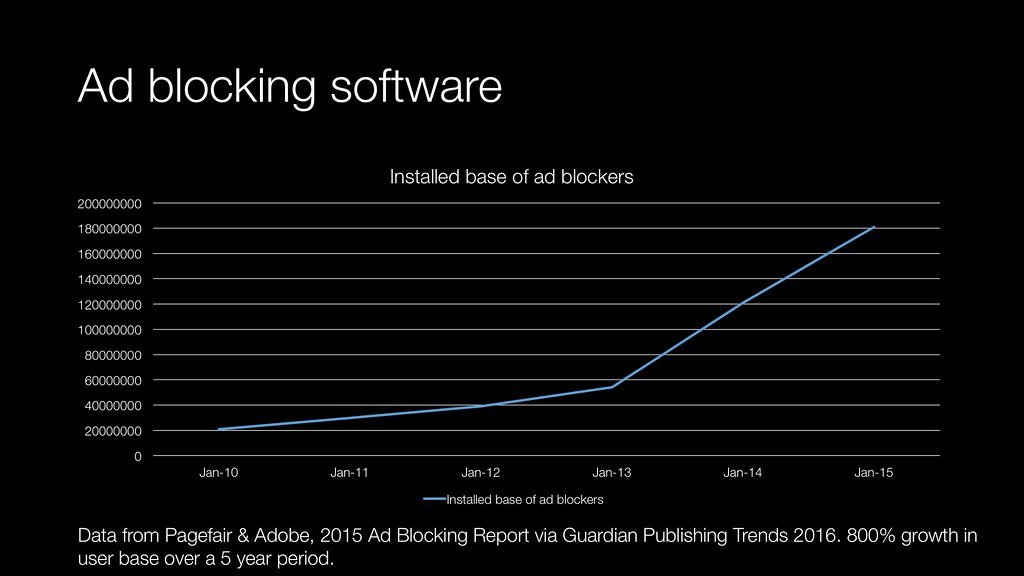In a world where banner ads assault our screens at every turn, a secret league of champions has risen to the occasion, armed with a digital superpower that changes the very fabric of online advertising. Ad blockers, the unsung disruptors of the advertising industry, have emerged as the formidable gladiators of our digital age. With the power to vanquish intrusive ads and restore serenity to our browsing experience, they have forever altered the game of digital advertising. In this article, we embark on a thrilling exploration of the ad-blocking revolution, shedding light on its impact, advantages, and potential consequences. Join us as we delve into the underbelly of online advertising and witness the dawn of a new era in the battle for our attention. Brace yourself, for the game is about to change, and the stakes have never been higher. 

The rise of ad blockers has been nothing short of a game-changer in the digital advertising landscape. With increasing numbers of internet users opting to install ad blocking software, advertisers have had to completely alter their strategies to reach their target audience effectively. Gone are the days of bombarding users with invasive, irrelevant ads that disrupt their browsing experience. Ad blockers have forced advertisers to rethink their approach and find better ways to engage with users in meaningful and non-intrusive ways.rn rnrnOne of the most significant impacts of ad blockers is the drastic transformation of user experience. Users who have grown frustrated with disruptive ads are now able to enjoy a more seamless and enjoyable online experience. Websites load faster, and users can navigate without being bombarded by pop-ups or auto-playing videos. This newfound power in the hands of consumers has forced advertisers to become more creative, craftier, and more respectful of users’ preferences. In this era of ad blockers, advertisers need to focus on creating engaging content that users genuinely want to interact with, rather than relying solely on disruptive ads. They must also explore alternative advertising channels, such as native advertising or sponsored content, to reach their target audience organically and with their consent. With the advent of ad blockers, the digital advertising game has changed forever, and advertisers must adapt and embrace innovative approaches to overcome the challenges it presents.rn
rnrnOne of the most significant impacts of ad blockers is the drastic transformation of user experience. Users who have grown frustrated with disruptive ads are now able to enjoy a more seamless and enjoyable online experience. Websites load faster, and users can navigate without being bombarded by pop-ups or auto-playing videos. This newfound power in the hands of consumers has forced advertisers to become more creative, craftier, and more respectful of users’ preferences. In this era of ad blockers, advertisers need to focus on creating engaging content that users genuinely want to interact with, rather than relying solely on disruptive ads. They must also explore alternative advertising channels, such as native advertising or sponsored content, to reach their target audience organically and with their consent. With the advent of ad blockers, the digital advertising game has changed forever, and advertisers must adapt and embrace innovative approaches to overcome the challenges it presents.rn
Q&A
Q: What exactly are ad blockers and how do they work?
A: Ad blockers are software programs or browser extensions that prevent advertisements from being displayed on websites. They typically work by filtering out content that is recognized as an advertisement, thus allowing users to browse the web without the constant interruption of ads.
Q: How do ad blockers impact the digital advertising industry?
A: Ad blockers have had a significant impact on the digital advertising industry. With more users adopting these tools, advertisers struggle to reach their target audience effectively, as their ads are being blocked. This has forced advertisers to rethink their strategies and find new ways to engage with consumers while respecting their ad-blocking preferences.
Q: What are the reasons behind the widespread use of ad blockers?
A: There are several reasons why ad blockers have gained widespread popularity. Users often install ad blockers to improve their online browsing experience by eliminating intrusive and irrelevant ads. They also help to reduce bandwidth usage, increase page loading speed, and protect against potential malware delivered through malicious ads.
Q: How do ad blockers affect online publishers and content creators?
A: Ad blockers heavily impact online publishers and content creators who rely on advertising revenue to sustain their operations. With the rise of ad blockers, these platforms face a decline in ad impressions, leading to a decrease in revenue. This has forced publishers to seek alternative sources of income or explore new ad formats that comply with users’ ad-blocking preferences.
Q: Are there any ethical concerns regarding the use of ad blockers?
A: The use of ad blockers raises ethical concerns for content creators and online publishers. While users have the right to control their browsing experience, the widespread use of ad blockers threatens the free content ecosystem by significantly reducing revenue streams for publishers. This calls for a balance between user experience and the sustainability of online content.
Q: How are advertisers adapting to the rise of ad blockers?
A: Advertisers are increasingly adapting their strategies to navigate the ad-blocking landscape. They are becoming more focused on delivering non-intrusive and relevant advertising experiences to engage with users who have opted to block ads. This has led to the rise of native advertising, influencer marketing, and other innovative approaches that align better with users’ preferences.
Q: Can ad-blocking technology be circumvented?
A: While ad-blocking technology continues to evolve, it is challenging to completely circumvent their impact. Ad-blocker developers constantly update their software to counter techniques used by advertisers to bypass the blockers. However, some companies have implemented anti-ad-blocking measures, although they often face backlash from users who value the control ad blockers provide.
Q: What does the future hold for ad blockers and digital advertising?
A: The future of ad blockers and digital advertising remains uncertain. As technology continues to advance, both sides will engage in a constant cat-and-mouse game. Advertisers will strive to find innovative ways to deliver appealing content, while ad-blocker developers aim to maintain control over users’ browsing experiences. Ultimately, the balance between user preference and the sustainability of online content will determine the direction this industry takes.
In Conclusion
In a world where digital advertising has become an unavoidable part of our online experience, ad blockers have emerged as a game-changer. With their ability to shield us from the intrusive, irrelevant, and sometimes downright annoying advertisements that flood our screens, ad blockers have revolutionized the way we consume content.
But what does this mean for the future of digital advertising? As the use of ad blockers continues to skyrocket, advertisers and content creators find themselves faced with new challenges and opportunities. No longer can they rely on traditional methods to capture and hold our attention. Instead, they must adapt, innovate, and think outside the box to deliver messages that resonate with their audience.
Ad blockers have forced advertisers to reconsider their strategies and prioritize quality over quantity, relevance over desperation. Gone are the days of bombarding users with pop-ups and obtrusive banners. In this new era, advertisers must create engaging, captivating, and truly valuable content that delivers a seamless user experience.
While some may argue that ad blockers threaten the revenue streams of publishers and content creators, others see them as a catalyst for positive change. With the rise of ad blockers, there is a growing demand for innovative advertising models that promote transparency and respect for users’ privacy. Advertisers must now seek out alternative methods such as native advertising, influencer partnerships, and sponsored content to effectively reach their target audience.
The game of digital advertising is undoubtedly changing, and whether we love them or hate them, ad blockers have played a significant role in this shift. They have pushed advertisers to rethink their approach, encouraging them to find new and creative ways to connect with their audience. As the industry continues to evolve, only time will tell what awaits us in the ever-changing landscape of digital advertising. But one thing is for certain: ad blockers have disrupted the game, prompting an era of innovation, accountability, and user-centered advertising.

